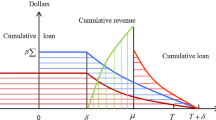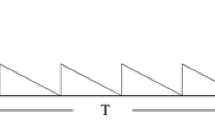Abstract
Products such as cattles and pigs can be processed into several types of products (parts) targeting different segments of customers, which belong to the so called coproducts. Mismatch risk is a significant issue in such coproduct supply chains. Under the Stackelberg game setting, we consider a coproduct supply chain consisting of one producer acting as the leader and one retailer being the follower and establish a stylized model to study how the mismatch risk should be allocated. Two supply chain modes are considered, i.e., the P-chain mode under which the producer is responsible for the processing activity and hence holds the mismatch risk, and the R-chain under which the retailer is responsible for the processing activity. We use the unbalanced ratio to reflect the degree of mismatch between supply and demand among different parts of the coproduct and study how the tradeoff between the bargaining power and the mismatch cost, by different mismatch risk allocations, influences the optimal decisions and the performances of the two parties as well as the whole supply chain. Our main findings include: (1) P-chain dominates R-chain from the perspective of the chain performance; and (2) the upstream producer is not always better off in the P-chain under which he bears more mismatch risk. Numerical study shows the robustness of our main results and further studies the effect of demand uncertainty and the processing cost on the performance of P-chain as compared to R-chain.














Similar content being viewed by others
References
Bansal, S., & Transchel, S. (2014). Managing supply risk for vertically differentiated co-products. Production and Operations Management, 23(9), 1577–1598.
Bitran, G., & Gilbert, S. (1994). Co-production processes with random yields in the semiconductor industry. Operations Research, 42(3), 476–491.
Boyabatli, O. (2015). Supply management in multiproduct firms with fixed proportions technology. Management Science, 61(12), 3013–3031.
Boyabatli, O., Nguyen, D. Q., & Wang, T. (2017). Capacity management in agricultural commodity processing and application in the palm industry. Manufacturing & Service Operations Management, 19(4), 551–567.
Cachon, G. P. (2004). The allocation of inventory risk in a supply chain: push, pull, and advance-purchase discount contracts. Management Science, 50(2), 222–238.
Chen, Y. J., Tomlin, B., & Wang, Y. (2013). Coproduct technologies: Product line design and process innovation. Management Science, 59(12), 2772–2789.
Chong, J. K., Ho, T. H., & Tang, C. S. (2001). A modeling framework for category assortment planning. Manufacturing & Service Operations Management, 3(3), 191–210.
Davis, A. M., Katok, E., & Santamarla, N. (2014). Push, pull, or both? A behavioral study of how the allocation of inventory risk affects channel efficiency. Management Science, 60(11), 2666–2683.
Dong, L., Kouvelis, P., & Wu, X. (2014). The value of operational flexibility in the presence of input and output price uncertainties with oil refining applications. Management Science, 60(12), 2908–2926.
Dong, L., & Zhu, K. (2007). Two-wholesale-price contracts: Push, pull, and advance-purchase discount contracts. Manufacturing & Service Operations Management, 9(3), 291–311.
Eric, O., & Sabyasachi, M. (2014). Physical and electronic wholesale markets: An empirical analysis of product sorting and market function. Journal of Management Information Systems, 31(2), 11–46.
Ferguson, M., Guide, V. D, Jr., Koca, E., & Souza, G. C. (2010). The value of quality grading in remanufacturing. Production & Operations Management, 18(3), 300–314.
Fine, C. H., & Freund, R. M. (1990). Optimal investment in product flexible manufacturing capacity. Management Science, 36(4), 449–466.
Galbreth, M. R., & Blackburn, J. D. (2006). Optimal acquisition and sorting policies for remanufacturing. Production & Operations Management, 15(3), 384–392.
Gilland, W. G., & Heese, H. S. (2013). Sequence matters: Shelf-space allocation under dynamic customer-driven substitution. Production & Operations Management, 22(4), 875–887.
Granot, D., & Yin, S. (2008). Competition and cooperation in decentralized push and pull assembly systems. Management Science, 54(4), 733–747.
Graves, S. C., & Tomlin, B. T. (2003). Process flexibility in supply chains. Management Science, 49(7), 907–919.
Gupta, D., Gerchak, Y., & Buzacott, J. A. (1992). The optimal mix of flexible and dedicated manufacturing capacities: Hedging against demand uncertainty. International Journal of Production Economics, 28(3), 309–319.
Honhon, D., & Pan, X. A. (2017). Improving profits by bundling vertically differentiated products. Production & Operations Management, 26(8), 1481–1497.
Jordan, W. C., & Graves, S. C. (1995). Principles on the benefits of man ufacturing process flexibility. Management Science, 41(4), 577–594.
Lariviere, M. A., & Porteus, E. (2001). Selling to the newsvendor: An analysis of price-only contracts. Manufacturing & Service Operations Management, 3(4), 293–305.
Li, S., & Tirupati, D. (1994). Dynamic capacity expansion problem with multiple products: Technology selection and timing of capacity additions. Operations Research, 42(5), 958–976.
Li, S., & Tirupati, D. (1995). Technology choice with stochastic demands and dynamic capacity allocation: A two-product analysis. Journal of Operations Management, 12(3), 239–258.
Li, S., & Tirupati, D. (1997). Impact of product mix flexibility and allocation policies on technology. Computers & Operations Research, 24(7), 611C626.
Nahmias, S., & Moinzadeh, K. (1997). Lot sizing with randomly graded yields. Operations Research, 47(6), 974–986.
Pan, X. A., & Honhon, D. (2012). Assortment planning for vertically differentiated products. Production & Operations Management, 21(2), 253–275.
Sunar, N., & Plambeck, E. (2016). Allocating emissions among coproducts: Implications for procurement and climate policy. Manufacturing & Service Operations Management, 18(3), 414–428.
Tomlin, B., & Wang, Y. (2005). On the value of mix flexibility and dual sourcing in unreliable newsvendor networks. Manufacturing & Service Operations Management, 7(1), 37–57.
Tomlin, B., & Wang, Y. (2008). Pricing and operational recourse in coproduction systems. Management Science, 54(3), 522–537.
Transchel, S., Bansal, S., & Deb, M. (2016). Managing production of hightech products with high production quality variability. International Journal of Production Research, 54(6), 1689–1707.
Van Mieghem, J. A. (1998). Investment strategies for flexible resources. Management Science, 44(8), 1071–1078.
Van Mieghem, J. A. (2004). Note-Commonality strategies: Value drivers and equivalence with flexible capacity and inventory substitution. Management Science, 50(3), 419–424.
Wang, Y., Niu, B., & Guo, P. (2014). The comparison of two vertical outsourcing structures under push and pull contracts. Production and Operations Management, 23(4), 610–625.
Yayla, H. M., Parlakturk, A. K., & Swaminathan, J. M. (2013). Multi-product quality competition: Impact of resource constraints. Production & Operations Management, 22(3), 603–614.
Yin, S. (2010). Alliance formation among perfectly complementary suppliers in a price-sensitive assembly system. Manufacturing & Service Operations Management, 12(3), 527–544.
Acknowledgements
The authors thanks the editor and the reviewers for their valuable comments on this paper. The paper is supported by NSFC (No. 71471085, 71671040, 71822103, 71871114) and NNSF of Jiangsu Province (BK20140279).
Author information
Authors and Affiliations
Corresponding author
Electronic supplementary material
Below is the link to the electronic supplementary material.
Rights and permissions
About this article
Cite this article
Peng, Y., Xu, X., Liang, X. et al. Mismatch risk allocation in a coproduct supply chain. Ann Oper Res 291, 707–730 (2020). https://doi.org/10.1007/s10479-018-3049-y
Published:
Issue Date:
DOI: https://doi.org/10.1007/s10479-018-3049-y




